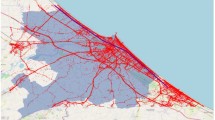Abstract
Wireless networks and mobile applications have grown very rapidly and have made a significant impact on computer systems. Especially, the usage of mobile phones and PDA is increased very rapidly. Added functions and values with these devices are thus greatly developed. If some regularity can be known from the user mobility behavior, then these functions and values can be further expanded and used intelligently. This paper thus attempts to mine appropriate linguistic mobility patterns for being used by mobile-system managers in future strategy planning. The location areas in which mobile users visit and their duration times can be found from the log data stored in the home-location-register module. Since the duration times are numeric, fuzzy concepts are used to process them and to form linguistic mobility patterns.
Preview
Unable to display preview. Download preview PDF.
Similar content being viewed by others
References
Agrawal, R., Srikant, R.: Mining Sequential Patterns. In: The Eleventh International Conference on Data Engineering, pp. 3–14 (1995)
Akyildiz, I.F., McNair, J., Ho, J., Uzunalioglu, H., Wang, W.: Mobility management in current and future communications networks. IEEE Network 12(4), 39–49 (1998)
Barbara, D.: Mobile computing and databases - a survey. IEEE Transactions on Knowledge and Data Engineering 11(1), 108–117 (1999)
Cai, C.H., Fu, W.C., Cheng, C.H., Kwong, W.W.: Mining association rules with weighted items. In: The International Database Engineering and Applications Symposium, pp. 68–77 (1998)
Chen, M.S., Han, J., Yu, P.S.: Data mining: an overview from a database perspective. IEEE Transactions on Knowledge and Data Engineering 8(6), 866–883 (1996)
Chintalapati, R.V.J., Kumar, V., Datta, A.: An adaptive location management algorithm for mobile computing. In: The 22th Annual IEEE Conference on Local Computer Networks, pp. 133–140 (1997)
Han, I., Cho, D.H.: Group location management for mobile subscribers on transportation systems in mobile communication networks. IEEE Transactions on Vehicular Technology 53(1), 181–191 (2004)
Hong, T.P., Kuo, C.S., Chi, S.C.: A data mining algorithm for transaction data with quantitative values. Intelligent Data Analysis 3(5), 363–376 (1999)
Hong, T.P., Lin, K.Y., Wang, S.L.: Mining linguistic browsing patterns in the world wide web. Soft Computing 6(5), 329–336 (2002)
Kruijt, N.E., Sparreboom, D., Schoute, F.C., Prasad, R.: Location management strategies for cellular mobile networks. IEEE Electronics & Communication Engineering Journal 10(2), 64–72 (1998)
Ma, W., Fang, Y.: A new location management strategy based on user mobility pattern for wireless networks. In: The 27th Annual IEEE Conference on Local Computer Networks (2002)
Peng, W.C., Chen, M.S.: Developing data allocation schemes by incremental mining of user moving patterns in a mobile computing system. IEEE Transactions on Knowledge and Data Engineering 15(1), 70–85 (2003)
Saygin, Y., Ulusoy, O.: Exploiting data mining techniques for broadcasting data in mobile computing environments. IEEE Transactions on Knowledge and Data Engineering 14(6), 1387–1399 (2002)
Wang, K., Liao, J.M., Chen, J.M.: Intelligent location tracking strategy in PCS. The IEE Proceedings on Communications 147(1), 63–68 (2000)
Yue, S., Tsang, E., Yeung, D., Shi, D.: Mining fuzzy association rules with weighted items. In: The IEEE International Conference on Systems, Man and Cybernetics, pp. 1906–1911 (2000)
Zadeh, L.A.: Fuzzy logic. IEEE Computer, 83–93 (1988)
Zimmermann, H.J.: Fuzzy Set Theory and Its Applications. Kluwer Academic Publisher, Boston (1991)
Author information
Authors and Affiliations
Editor information
Editors and Affiliations
Rights and permissions
Copyright information
© 2005 Springer-Verlag Berlin Heidelberg
About this paper
Cite this paper
Hong, TP., Huang, CM., Horng, SJ. (2005). Mining Linguistic Mobility Patterns for Wireless Networks. In: Khosla, R., Howlett, R.J., Jain, L.C. (eds) Knowledge-Based Intelligent Information and Engineering Systems. KES 2005. Lecture Notes in Computer Science(), vol 3683. Springer, Berlin, Heidelberg. https://doi.org/10.1007/11553939_188
Download citation
DOI: https://doi.org/10.1007/11553939_188
Publisher Name: Springer, Berlin, Heidelberg
Print ISBN: 978-3-540-28896-1
Online ISBN: 978-3-540-31990-0
eBook Packages: Computer ScienceComputer Science (R0)




